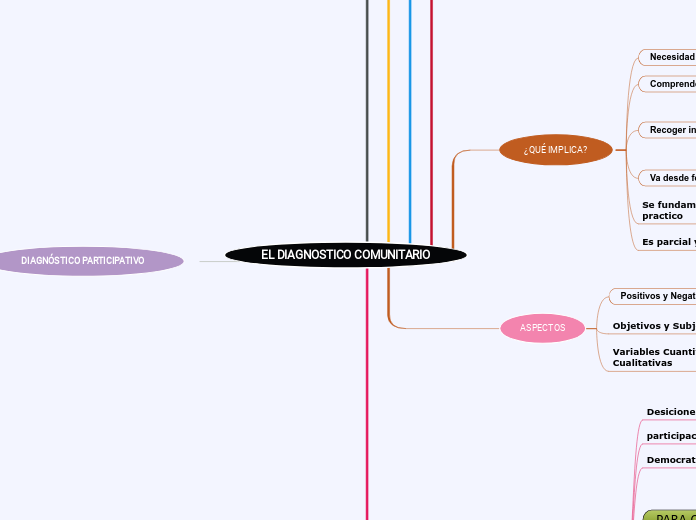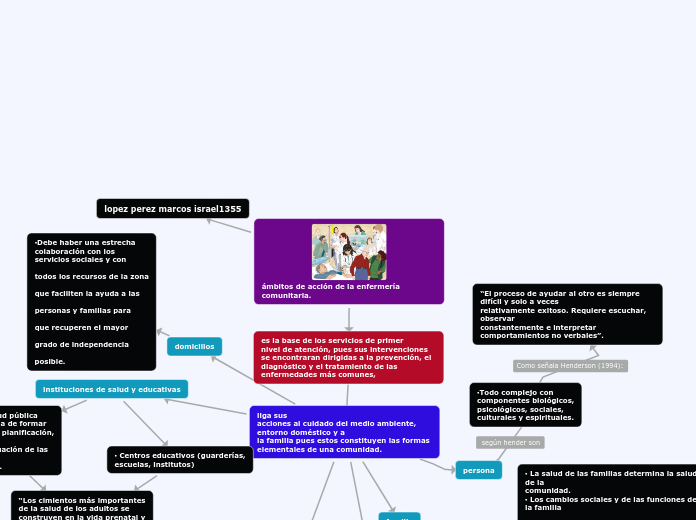EL DIAGNOSTICO COMUNITARIO
The Solar System is the gravitationally bound system of the Sun and the objects that orbit it, either directly or indirectly. Of the objects that orbit the Sun directly, the largest are the eight planets, with the remainder being smaller objects, the dwarf planets, and small Solar System bodies.
DIAGNOSTICO PARTICIPATIVO
COMO PROCESO EDUCATIVO
SOLUCIÓN
COMUNICAR RESULTADOS
Generar ideas
Conocer a fondo el porblema
RECURSOS
ANALISIS Y FORMULAR PREGUNTAS
Preguntas claves
Causas y relaciones
DELIMITARLO
Identificar el problema CENTRAL
Disposición de la comunidad para superar
Cantidad de afectados
Gravedad y urgecncia del problema
PARA QUE?
DAR PROPUESTAS
MOTIVAR
SELECCIONAR AREAS DE INTERVENCION
CONOCER REALIDADES
Democratico
participacion amplia
Desiciones colectivas
ASPECTOS
Variables Cuantitativas y Cualitativas
Abordar todos los ascpectos
Objetivos y Subjetivos
Tener en cuenta el objetivo y las realidades
Positivos y Negativos
Aunque este centrado en necesidades también hay participacion y organizacion
DIAGNÓSTICO PARTICIPATIVO
It was once considered a planet but in August 2006 the International Astronomical Union (IAU) downgraded the status of Pluto to that of “dwarf planet.”
Pluto is unlike other planets in many respects. It is smaller than Earth's moon; its orbit is highly elliptical.
It's a cold, rocky world with a tenuous atmosphere. Pluto is a very active ice world that's covered in glaciers, mountains of ice water, icy dunes, and possibly even cryovolcanoes that erupt icy lava made of water, methane or ammonia.
FASES
CIERRE, DIFUSIÓN Y PROGRAMACIÓN
DEBATE SOCIAL SOBRE LOS RESULTADOS Y DEFINICION DE LINEAS
TRABAJO DE CAMPO
DEFINICIÓN DEL PROYECTO Y DIAGNOSTICO PREVIO
El paso de los síntomas a los temas de fondo como proyecto transformador
Recursos,oportunidades y potencialidades
PARTICIPACIÓN
MODELOS CULTURALES
ECONOMÍA Y TRABAJO
TERRITORIO Y MEDIO AMBIENTE
PROCESO DE AUTOANÁLISIS DE LA COMUNIDAD LOCAL
CONSTRUCCION DE RELACIONES SOCIALES
Permitir a los actores recrear las redes sociales
IMPLICACIÓN PROGRESIVA
Corresponsabilizar a los actores
AUTOAPRENDIZAJE DE LA REALIDAD
SE PROPONEN DOS ALTERNATIVAS
posición constructi-
vo-transformadora
Quiere ir más allá de los síntomas,
para abordar los temas de fondo.
posición pragmático-reformista
A lo máximo que se puede aspirar es a identificar
las necesidades más manifiestas
No pueden haber extremos
Comunidad destruida
Comunidad perfecta
Desempeña dos papeles
How long does it take for Pluto to go around the sun?
Pone a los actores en condicio-
nes de hacerlo,
Pone sobre mesa temas a debatir
Los diagnósticos participativos son diferentes
Accion politica
Producir determinados efectos
¿QUÉ IMPLICA?
Jupiter is a giant gas world that is the most massive planet in our solar system.
Its swirling clouds are colorful due to different types of trace gases.
And a major feature in its swirling clouds is the Great Red Spot, a giant storm more than 10,000 miles wide. It has raged at more than 400 mph for the last 150 years, at least.
Jupiter has a strong magnetic field, and with 75 moons, it looks a bit like a miniature solar system.
Es parcial y permanente
Por su dinamismo
Se fundamenta en la teoría y es practico
Va desde fenómenos hasta la escencia
Jupiter has a strong magnetic field, and with 75 moons, it looks a bit like a miniature solar system.
Name the 4 most known moons.
De lo general a lo contreto
Recoger información y reflexionar
How long does it take for Jupiter to go around the sun?
R:Explicar y discutir sobre el desarrollo del problema
RI: Datos para conocer la realidad, a través de antecedentes y fuentes
Comprender para resolver
A planet's day is the time it takes the planet to rotate or spin once on its axis.
Write down Jupiter's day measured in Earth days.
Necesidad o problema
Punto de partida
¿POR QUE ES IMPORTANTE?
Mars is a cold, desert-like place covered in dust. This dust is made of iron oxides, giving the planet its iconic red hue.
Mars shares similarities with Earth: It is rocky, has mountains, valleys and canyons, and storm systems ranging from localized tornado-like dust devils to planet-engulfing dust storms.
Llevar a cabo acciones aptas
How long does it take for Mars to go around the sun?
Claridad
A planet's day is the time it takes the planet to rotate or spin once on its axis.
Write down Mars's day measured in Earth days.
causas y relacion con los problemas
Asertividad y prioridad
Problemáticas
Desde lo NO medico
Earth is a water world, with two-thirds of the planet covered by oceans.
It's the only world known to harbor life.
Earth's atmosphere is rich in nitrogen and oxygen.
Its name originates from 'Die Erde,' the German word for 'the ground.'
Earth may once have had two moons, nowadays it has just one.
Planificar acciones viables
A planet's day is the time it takes the planet to rotate or spin once on its axis.
Write down the Earth's day in hours.
Diagnosticar es INVESTIGAR
Conocer y comprender problemas
En terapia ocupacional
Venus is Earth's twin in size and has no moons.
Its surface has various mountains and volcanoes. Because of its thick, toxic atmosphere that's made of sulfuric acid clouds, Venus is an extreme example of the greenhouse effect. The average temperature on Venus' surface is 900 F (465 C).
Venus spins slowly from east to west, the opposite direction to most of the other planets.
The Greeks believed Venus was two different objects — one in the morning sky and another in the evening. Because it is often brighter than any other object in the sky, Venus has generated many UFO reports.
Evaluación de necesidades
perfil ocupacional y en el análisis desempeño
Según el ámbito medico
Mercury is the smallest, only a little bit larger than Earth's moon. Mercury has no moon.
It experiences dramatic changes in its day and night temperatures: Day temperatures can reach a scorching 840 F (450 C), which is hot enough to melt lead. Meanwhile, on the night side, temperatures drop to minus 290 F (minus 180 C).
It also has a very thin atmosphere of oxygen, sodium, hydrogen, helium, and potassium and can't break-up incoming meteors, so its surface is pockmarked with craters, just like the moon.
Procedimiento para identificar una enfermedad
A planet's day is the time it takes the planet to rotate or spin once on its axis.
Write down Mercury's day measured in Earth days.
Síntomas y signos
Conocer la naturaleza de la enfermedad
Our Solar System has eight “official” planets which orbit the Sun.
Each planet is at a different distance from the sun. Name its position.
Observación









